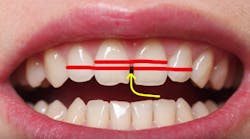We need to have better conversations about DIY dentistry
This article originally appeared in the Principles of Practice Management e-newsletter. Subscribe to this informative twice monthly practice management ENL here.
We are witnessing the rise of companies that allow customers to perform irreversible dental procedures on themselves. While at-home whitening solutions have been around for roughly two decades without too much controversy, at-home orthodontics has generated significantly more concern. I welcome disruptive technology and I welcome ways to make dentistry more accessible and affordable for the public. But oral health professionals are within their rights to express concerns about new methods of care that have not been subject to proper clinical research.
Does anyone else remember the “gap band” fad from a few years ago? People were closing diastema with small elastics thanks to promotions from YouTube personalities, and from at least one company that was selling the bands. This, of course, is an extremely bad idea. Fortunately, some news outlets picked up on the dangerous trend and shared warnings from the dental community.
Now here we are in 2018 with concerns about a new DIY dentistry trend: clear aligner therapy that is performed without direct dental supervision. It’s important for oral health professionals to engage these companies and the public in spirited debate on whether or not DIY aligner therapy is safe and effective. But if you’re going to do so, let’s get some concepts straight so we don’t blow it.
1) Don’t use the “They took our jobs!” defense.
We are living in the Third Industrial Revolution. New forms of energy, transportation, and communication are influencing us at a dizzying pace. As I mentioned in my Dental Economics editorial last year, revolutions have their casualties. Simply arguing that DIY dentistry puts dentists out of work is a terrible, terrible argument. First, no one has any sympathy for dentists losing business. Second, progress leaves outdated jobs in its wake. We should be arguing that DIY aligner therapy doesn’t make traditional orthodontics obsolete and is potentially dangerous and ineffective.
2) Don’t get hung up on DIY impressions.
One of the clinical concerns that had been raised was that customers were expected to take their own impressions. Any dental care professional can tell you that taking impressions is no easy feat and it seems problematic to leave it to someone who has never done it before. I think that’s a legitimate concern, however, that will be shortly solved. At least one DIY aligner company now has several store locations that provide intraoral scans. So, let’s not cling to this argument too tightly; there are other clinical concerns that can be raised.
3) Do protect patient rights.
One DIY aligner company shares its Terms of Service and I found it troubling. This paragraph stood out to me:
“All disputes arising out of or related to this agreement or any aspect of the relationship between you, on the one hand, and Candid Co, Inc. or its supplier of vendors, on the other hand, whether based in contract, tort, statute, fraud, misrepresentation, or any other legal theory, will be resolved through final and binding arbitration before a neutral arbitrator instead of in a court by a judge or jury and you agree that Candid Co, Inc. and you are each waiving the right to trial by a jury. You agree that any arbitration under this agreement will take place on an individual basis; class arbitrations and class actions are not permitted and you are agreeing to give up the ability to participate in a class action.”
I’m not an attorney, but I’m pretty sure I couldn’t have my patients sign a waiver that prevented them from taking me to court and that barred them from class action lawsuits. As much as dentists like to complain about malpractice litigation, and as much as we can cite anecdotal examples of dentists unjustly losing cases, let’s admit that the justice system is an important check and balance. Dentists are beholding to their dental society (local, state, and national), their state board, litigious patients, and a host of other regulatory bodies. It’s annoying but it’s ultimately a good thing. Companies that interject their products and services into the doctor-patient relationship should be held accountable for any wrong doing. DIY dentistry customers may have little recourse if things go wrong.
So, my friends, I will say again that we must engage the public and these DIY companies in spirited debate. We should share our concerns for the welfare of patients and, most of all, we should listen. It’s up to us to raise the level of debate.
Feel free to continue the discussion on the PPM Facebook group.
Cheers,
Chris
MORE OP ED ARTICLES FROM DR. SALIERNO
Should associates have to pay their lab bills?
Please stop complaining about the Wall Street Journal article
Alexa is in my operatory … now what?







